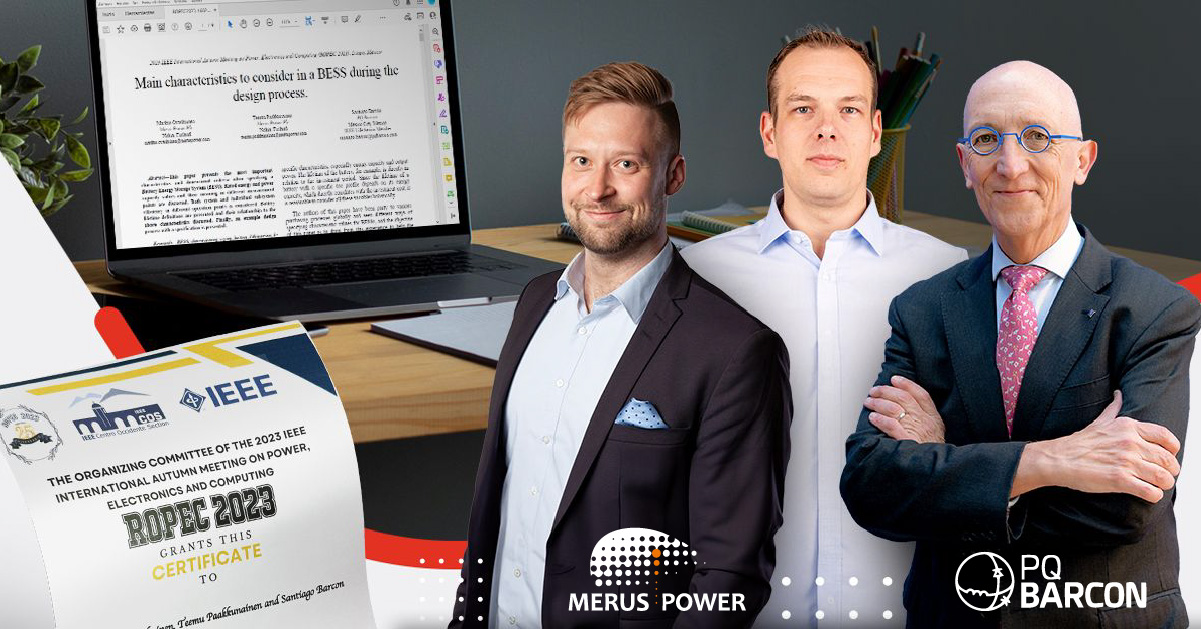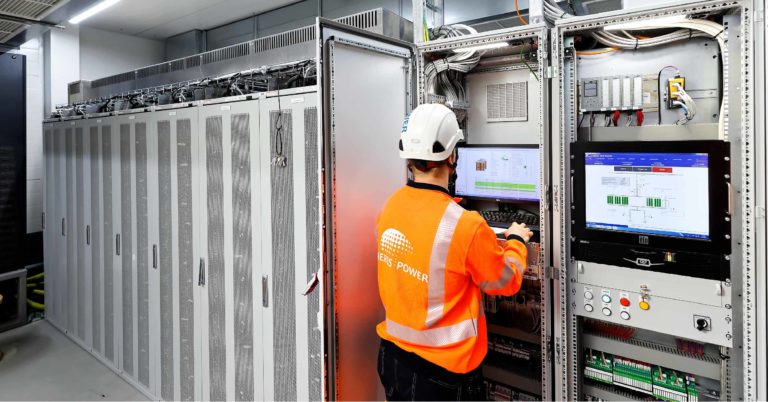
Understanding the essentials of battery energy storage system design
In the precise and complex realm of battery energy storage systems (BESS), every detail in the design can have a significant impact on the system’s efficiency and its operational lifespan.
Lending their expertise to this field, Markus Ovaskainen, the Sales Director, and Teemu Paakkunainen, the Energy Storage Product Manager at Merus Power, have collaborated with Santiago Barcón, the CEO of PQ Barcón, Merus Power’s strategic partner in Mexico. Together, they have authored a technical paper that elucidates the critical factors to consider throughout the BESS design process, titled “The main characteristics to consider in a battery energy storage system during the design process”.
The insightful paper made its debut at the ROPEC 2023, the 2023 IEEE Autumn Meeting on Power, Electronics and Computing conference in Ixtapa, México, marking a significant milestone in Merus Power’s collaborative efforts. Santiago Barcón, was not only the co-author of the paper, but he played a crucial role in its publication and presentation at the ROPEC 2023. His local insight and efforts were instrumental in bringing this paper to a wider audience. The paper is set to be indexed in the prestigious IEEE Xplore’s Digital Library.
Lithium-ion BESS: Engineering the core of energy storage systems
In the paper, the authors concentrate on lithium-ion-based systems, leading the charge in the energy storage revolution. The design process starts with defining rated energy and power capacity values, considering system efficiency, and planning for the battery’s lifecycle. Each component—from batteries to cooling systems—plays a significant role in the final specification.
Rated values and efficiency
The paper underscores that rated values for energy storages are not one-size-fits-all. A clear understanding of terms like energy capacity and power rating is crucial, as these can differ based on where in the system they are measured. Additionally, the efficiency of an energy storage system is highlighted through Round-Trip Efficiency (RTE), which varies with the operation point, reflecting the system’s true performance.
Power-to-energy ratio
This ratio is a design cornerstone. Depending on the application—whether it’s for peak shaving or load leveling—the required power and energy characteristics can vary greatly, impacting cost and functionality.
Lifetime and degradation
Any battery energy storage system is subject to wear and tear. The authors discuss how lithium-ion batteries experience calendar and cyclical degradation. Factors such as temperature and state of charge are pivotal, affecting the system’s degradation rate and, consequently, its lifespan.
Merus Power, your technical partner in energy storage business cases
At Merus Power, we pride ourselves on being experienced developers and manufacturers of energy storage solutions. Our smart Merus® ESS is a high-power, fast-reacting, and reliable lithium-ion-based battery energy storage system that exemplifies the advanced technology that has been at the core of our power quality products for years. Our comprehensive offerings include everything from design and supply to testing, commissioning, and engineering, procurement, and construction (EPC) works, all supported by a wide-reaching, skilled partner network both in Finland and internationally.
We know that crafting viable energy storage business cases is a team effort, requiring a blend of electricity market know-how, battery technology, and power electronics expertise. Our approach is to work in sync with our customers, understanding their unique requirements and investment capacity to co-create a business model that isn’t just a strategic fit but is also adaptable to the energy sector’s evolving nature.
Through partnership and deep market insight, we align with our customers to maximize the potential of Merus® ESS. We’re committed to developing solutions that are economically, technically, and strategically robust, paving the way for a profitable and sustainable energy future.

Merus® ESS – Energy storage system
Merus® Energy Storage System is a scalable lithium-ion battery energy storage system fully designed by Merus Power.
Conclusion
This paper is more than just a technical manual; it’s a call for a standardized language in BESS design. The detailed analysis provided by Ovaskainen, Paakkunainen, and Barcón proposes a framework for clear specifications, aiding in the comparison of systems and ensuring that an energy storage system, like our Merus® ESS, is designed to meet its intended operational life.
For those not entrenched in electrical engineering jargon, here’s the crux: Battery energy storage system design is a meticulous process that demands a deep understanding of various components and how they interplay to affect the system’s efficiency and durability. With the Merus® ESS, clarity in design specifications is paramount, and the attention to detail is evident in its performance, establishing it as a system that doesn’t just operate but excels. As we move towards a more sustainable future, the role of energy storage systems like Merus® ESS becomes ever more critical. The insights provided by experts like Ovaskainen, Paakkunainen, and Barcón pave the way for more informed decisions in the realm of energy storage, where every watt counts.
